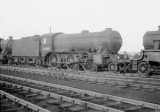
GNR Class H3
Encyclopedia
The Great Northern Railway
Class H4 (classified K3 by the LNER) was a class of 2-6-0
steam locomotive
designed for mixed-traffic work.
The type was a more powerful development of the earlier H3
(LNER K2) class and was notable at the time, as the 6 feet (1.8 m) boilers were the largest fitted to any British locomotive to that date. After formation of the London and North Eastern Railway
, the type became known as class K3 and was adopted as an LNER standard design.
in 1920, to the design of Nigel Gresley
. Six further batches were built at Doncaster and Darlington Works
, Armstrong Whitworth
, Robert Stephenson and Company
and the North British Locomotive Company
. The last examples were delivered in 1937, with a total of 193 locomotives having been built.
rebuilt K3 No. 206 into a two-cylinder engine forming the LNER Class K5
. No more were so treated, although some later received K5 type boilers.
Great Northern Railway (Great Britain)
The Great Northern Railway was a British railway company established by the Great Northern Railway Act of 1846. On 1 January 1923 the company lost its identity as a constituent of the newly formed London and North Eastern Railway....
Class H4 (classified K3 by the LNER) was a class of 2-6-0
2-6-0
Under the Whyte notation for the classification of steam locomotives, 2-6-0 represents the wheel arrangement of two leading wheels on one axle, usually in a leading truck, six powered and coupled driving wheels on three axles, and no trailing wheels. This arrangement is commonly called a Mogul...
steam locomotive
Steam locomotive
A steam locomotive is a railway locomotive that produces its power through a steam engine. These locomotives are fueled by burning some combustible material, usually coal, wood or oil, to produce steam in a boiler, which drives the steam engine...
designed for mixed-traffic work.
The type was a more powerful development of the earlier H3
GNR Class H3
The Great Northern Railway Class H4 was a class of 2-6-0 steam locomotive designed for mixed-traffic work.The type was a more powerful development of the earlier H3 class and was notable at the time, as the boilers were the largest fitted to any British locomotive to that date...
(LNER K2) class and was notable at the time, as the 6 feet (1.8 m) boilers were the largest fitted to any British locomotive to that date. After formation of the London and North Eastern Railway
London and North Eastern Railway
The London and North Eastern Railway was the second-largest of the "Big Four" railway companies created by the Railways Act 1921 in Britain...
, the type became known as class K3 and was adopted as an LNER standard design.
Construction
The first ten locomotives were built at the GNR's Doncaster WorksDoncaster Works
Doncaster railway works is in the town of Doncaster, South Yorkshire, England.Always referred to as "the Plant", it was established by the Great Northern Railway in 1853, replacing the previous works in Boston and Peterborough...
in 1920, to the design of Nigel Gresley
Nigel Gresley
Sir Herbert Nigel Gresley was one of Britain's most famous steam locomotive engineers, who rose to become Chief Mechanical Engineer of the London and North Eastern Railway . He was the designer of some of the most famous steam locomotives in Britain, including the LNER Class A1 and LNER Class A4...
. Six further batches were built at Doncaster and Darlington Works
Darlington Works
Darlington railway works, known in the town as North Road Shops, was built in 1863 by the Stockton and Darlington Railway in the town of Darlington in the north east of England.-NER History:The first new locomotive was built at the works in 1864...
, Armstrong Whitworth
Armstrong Whitworth
Sir W G Armstrong Whitworth & Co Ltd was a major British manufacturing company of the early years of the 20th century. Headquartered in Elswick, Newcastle upon Tyne, Armstrong Whitworth engaged in the construction of armaments, ships, locomotives, automobiles, and aircraft.-History:In 1847,...
, Robert Stephenson and Company
Robert Stephenson and Company
Robert Stephenson and Company was a locomotive manufacturing company founded in 1823. It was the first company set up specifically to build railway engines.- Foundation and early success :...
and the North British Locomotive Company
North British Locomotive Company
The North British Locomotive Company was created in 1903 through the merger of three Glasgow locomotive manufacturing companies; Sharp Stewart and Company , Neilson, Reid and Company and Dübs and Company , creating the largest locomotive manufacturing company in Europe.Its main factories were...
. The last examples were delivered in 1937, with a total of 193 locomotives having been built.
Use
They were excellent mixed-traffic locomotives, although their large size restricted their route availability. In their latter years they were primarily employed on vacuum-fitted freight traffic.Class K5
In 1945, Edward ThompsonEdward Thompson
Edward Thompson is the name of:* Edward Thompson , English landowner and politician* Edward Thompson , MP and Lord of the Admiralty...
rebuilt K3 No. 206 into a two-cylinder engine forming the LNER Class K5
LNER Class K5
The London and North Eastern Railway Class K5 consisted of a single rebuild of LNER Class K3 2-6-0 No. 206 , rebuilt in 1945 by Edward Thompson. The rebuilt locomotive had a new boiler and two, instead of three, cylinders following earlier rebuilds of other Gresley designs...
. No more were so treated, although some later received K5 type boilers.

